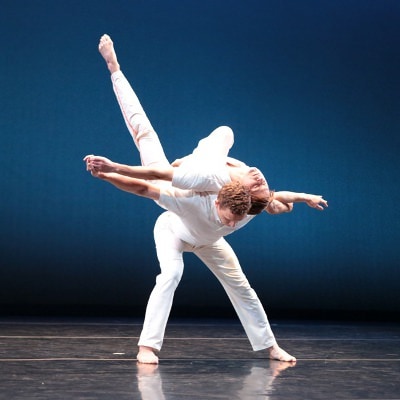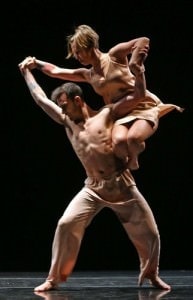According to Jackson Pollock, “Art isn’t finished until someone sees it.” Similarly, Lar Lubovitch expressed verbally and through choreography that “Dance doesn’t find meaning until the audience observes it.” The audience’s laser focus let not one move go unnoticed. One of the many highlights of yesterday evening’s performance by Lar Lubovitch Dance Company at George Mason University’s Center for the Arts was the post-performance discussion with Lar Lubovitch and the head of the dance program at GMU, Susan Shields. Shields used to dance with Lubovitch’s company. (All quoted remarks are those given by Lubovitch last night).

This 45th Anniversary Season and Lar Lubovitch’s 70th year of life, brought with it a different line-up than Lubovitch usually presents. A self-proclaimed hater of ‘old pieces’ would rather showcase new works which reflect his current choreography skills and the dancers that “speak poetry as they dance.” Lubovitch also stated that “Today’s dancers are more of dance linguists, trained in many different styles and able to mix and meld them as called for.” Lubovitch expects dancers to “play music with their body.”
The evening began with three duets, all danced brilliantly. The first, Concerto Six Twenty-Two, (1986), was set to Mozart’s Concerto for Clarinet and Orchestra. Featuring dancers Attila Joey Csiki and Tobin Del Cuore, the duet was all about trust and connection. The lifts and arm work were truly special. This theme shows attention to context, given that it was choreographed during the time that AIDS was becoming a national issue. This was the first of many performances in which the original lighting, designed by Craig Miller and recreated by Jack Mehler, complimented rather than competed with, the choreography.
The second duet, Vez (2013) was initially choreographed to Bolero by Maurice Ravel (1928) and titled Fandango (1987). Lubovitch felt the music did not fully reflect his ideas and commissioned a new score by Randall Woolf in 2013. Mellisa Hughs, vocals and Gyan Riley, guitars, emphasized the tension within the dance. This Washington area premiere included much floor work, emphasizing the gravitas of the piece. Nicole Corea and Clifton Brown showed both power and passion in their ovement agains a background slice of red light. Corea and Brown painted a picture of struggle between dominance and freedom. Near the end, the two tried to meld together but were unsuccessful because of their emotional past. Lubovitch explained that the change in music greatly changed the dance; not the moves, but the quality of the dance, making it more rounded.
I anticipated the theme of the third duet, The Time Before and the Time After (1970), set to Igor Stravinsky’s Concerto for String Quartet to be an earlier version of Vez. Choreography and execution showed something completely different. Also about the difficulties of relationships, Time, danced by Katarzyna Sharpetowska and Reed Luplau, focused more on the contrast between anger and indifference over the passage of time. While dancing close together, and often in lifts, Sharpetowska showed the broken form emblematic of contemporary dance and foreign to classical ballet. Anger was brought to the fore through stomping and arm movement while indifference was illustrated, in part, throughout by the drab beige costumes designed by Reid Bartelme.

The much anticipated Transparent Things (2012), set to Claude Debussy’s String Quartet in G Minor, Opus 10, was performed after the first intermission. The original concept was drawn from Picasso’s, Family of Saltimbanques (1905), showing itinerant street performers alone in a field after a day of work. The concept was that the joy of performance exists only in the realm and time performed. Afterwards, it is only a memory. Lead dancer, Csiki, showed contrasting emotions while participating in one movement or sleeping through another. Lubovitch later explained that the four movements represented, in order: 1) getting ready for a performance, 2) the performance, 3) re-entry of dancers into the world of aches, pains and injuries right after the performance, and, 4) the next day’s performance. This was different from my perception that it was Csiki’s movements represented feelings from the performance viewer’s persective. Since dance interpretation is in the emotions of the beholder, both perspectives make sense to me. The ensemble also included Skarpowska with Luplau, Brian McGinnes, and Laura Rutledge with Clifton Brown. Lubovitch noted that the music by Debussy was composed 12 years before Picasso’s painting and paired well because that the artists shared a sense of transparency.
The story behind Crisis Variations (2011), the final piece of the evening, is one worth repeating. Lubovitch explained to the dancers that he wanted them to embody the feeling of riding in a van as it goes over a cliff. In addition, he wanted the piece to reflect the tension and lack of control most experience in today’s world. Crisis Variations was choreographed to Franz Liszt’s Transcendental Etudes for Piano. Then, the day before the first performance, Lubovitch surprised the company by substituting a completely different score, this one composed by Yevgheniy Sharlat in 2011. That certainly amped up the crisis mode! A combination of scurrying floor work by most of the dancers contrasted with the duo comprised of McGinnis and Skarpetowska. They illustrated themes related to attempts to establish certainty in the overwhelming uncertainty and the crisis mode in which the nation seems stuck. The stage was very dark, suggesting the coldness of our world. The dance incorporated all members of the company, including Jonathan E. Alsberry and Anthony Boccini.
After Crisis Variations, and well into the half hour discussion with Lubovitch and Shields, thoughts of the piece were foremost in many a mind. The visuals etched onto the brain were hard to shake and the emotions evoked were still resonating. One could understand why this powerful choreography was awarded the 2012 Prix Benois de la Danse for Choreography at the Bolshoi Theatre in Moscow.
Running time: Two hours and thirty minutes, including two intermissions, and a post- performance discussion.
Lar Lubovitch Dance Company 45th Anniversary Season was performed on October 26, 2013 at the George Mason University Center for the Arts-4373 Mason Pond Drive, in Fairfax, VA. For future performances at The Center for the Arts, check their calendar of events.




